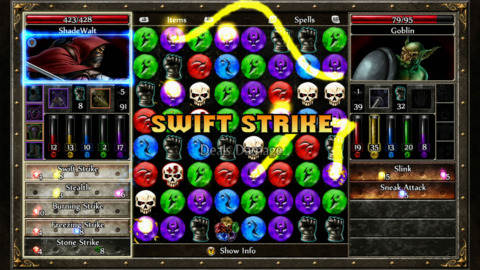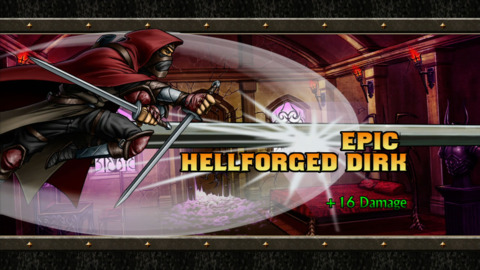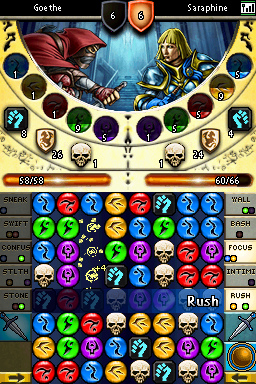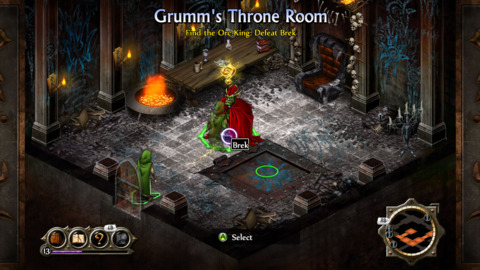
Some of Infinite Interactive's other puzzle/RPG hybrids, like Galactrix and Neopets Puzzle Adventure, tried too hard to change up core elements that didn't need changing. No such problem here. Instead of trying to get fancy with new and overly complex puzzle mechanics, the developer kept the part that worked in the original game, namely the traditional match-three puzzle gameplay. But the puzzle-based battles are leaner and more focused on strategy than before. Extraneous pieces like experience gems and coins are gone; now it's just five types of colored mana (for spells), gauntlet-shaped action pieces (for weapon attacks), and skulls (for direct damage) on the board.
With five types of mana available, there's a greater diversity of spells at your disposal and a wider range of ways you can use them to interact with the pieces on the board and then create utterly devastating combination attacks. The types of spells available depend on your character class-- barbarian, assassin, templar, or sorcerer--and naturally cater to different play styles. I played the hearty, all-around barbarian on the DS version before switching to the less survivable but deadlier assassin on Xbox Live Arcade. Discovering the ins and outs of your class and finding the most efficient ways to slaughter all the monsters in your path is one of the best things about the game. There's a lot of strategy and a tangible, rewarding sense of progression involved.

The famously lucky AI (some called it "cheating") from the first game is basically nonexistent in this sequel. Enemies rarely get those ridiculous six- and eight-part cascading matches they would routinely get in every battle last time, and even when they do, the effects are far less devastating. If anything, the game almost got too easy as I leveled up, crafted better gear, and figured out more powerful ways to put together all the spells (of which you can only equip five at a time) I was unlocking. Of course, it's always a good idea to prevent the enemy from matching skulls to attack you with, but when you've got a poisoned dagger that does six damage every turn for eight straight turns, a sword that hits for 17 in a single swipe, and spells that can do anywhere from 40 to 100 damage in a single combined assault (depending on the layout of the board), it almost feels like a waste of time doing a paltry three to five damage by matching skulls yourself. I loved the way the combat dynamic evolved to focus more on my unique skills and equipment as my character got more powerful.

Looking at screenshots, you might get the impression Puzzle Quest 2 is a full-on dungeon romp, but you don't actually do much exploring. The dungeon screens aren't much more than glorified menus where you click on doorways or characters you want to interact with, and your character merely moves along predefined paths between these points of interest, fighting the enemies that get in the way. This limitation didn't bother me much, since you're still getting to see new areas and enemy types on a regular basis, and there's still a decent amount of freedom to explore the parts of the dungeon you want to explore.

It's nice to see Infinite getting back to what made Puzzle Quest great in the first place. This sequel does a fine job of keeping and improving on the good parts while layering on the sort of character progression and strategy that makes you want to keep plowing ahead, long after the game would have otherwise gotten boring. I'd lean toward recommending the Xbox version because, well, I like achievements, and because it's half the price of the DS cart. But whether you want to play on the couch or on the go, Puzzle Quest 2 is a great way to wile away a few minutes, or a few hours.